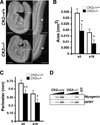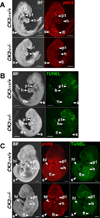CK2α is essential for embryonic morphogenesis
- PMID: 21761203
- PMCID: PMC3756899
- DOI: 10.1007/s11010-011-0961-8
CK2α is essential for embryonic morphogenesis
Abstract
CK2 is a highly conserved serine-threonine kinase involved in biological processes such as embryonic development, circadian rhythms, inflammation, and cancer. Biochemical experiments have implicated CK2 in the control of several cellular processes and in the regulation of signal transduction pathways. Our laboratory is interested in characterizing the cellular, signaling, and molecular mechanisms regulated by CK2 during early embryonic development. For this purpose, animal models, including mice deficient in CK2 genes, are indispensable tools. Using CK2α gene-deficient mice, we have recently shown that CK2α is a critical regulator of mid-gestational morphogenetic processes, as CK2α deficiency results in defects in heart, brain, pharyngeal arch, tail bud, limb bud, and somite formation. Morphogenetic processes depend upon the precise coordination of essential cellular processes in which CK2 has been implicated, such as proliferation and survival. Here, we summarize the overall phenotype found in CK2α (-/- ) mice and describe our initial analysis aimed to identify the cellular processes affected in CK2α mutants.
Figures





References
-
- Xu X, Toselli PA, Russell LD, Seldin DC. Globozoospermia in mice lacking the casein kinase II alpha' catalytic subunit. Nat Genet. 1999;23(1):118–121. - PubMed
-
- Moreno-Romero J, Espunya MC, Platara M, Arino J, Martinez MC. A role for protein kinase CK2 in plant development: evidence obtained using a dominant-negative mutant. Plant J. 2008;55(1):118–130. - PubMed
-
- Allada R, Meissner RA. Casein kinase 2, circadian clocks, and the flight from mutagenic light. Mol Cell Biochem. 2005;274(1–2):141–149. - PubMed
Publication types
MeSH terms
Substances
Grants and funding
LinkOut - more resources
Full Text Sources

